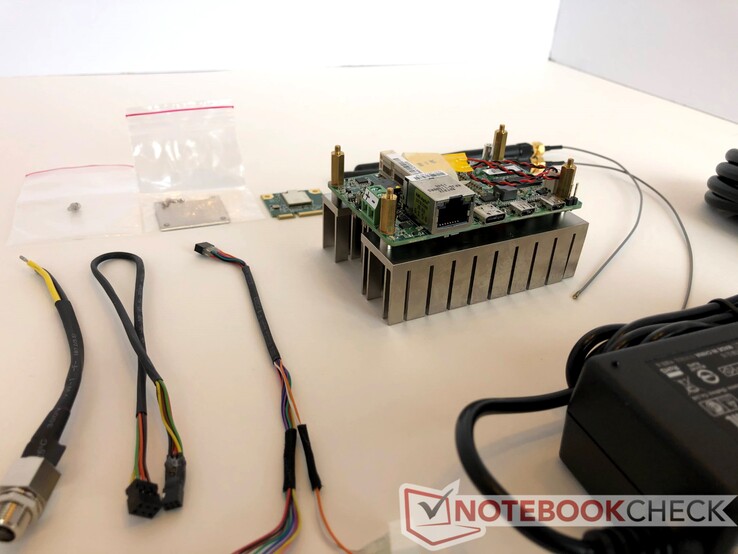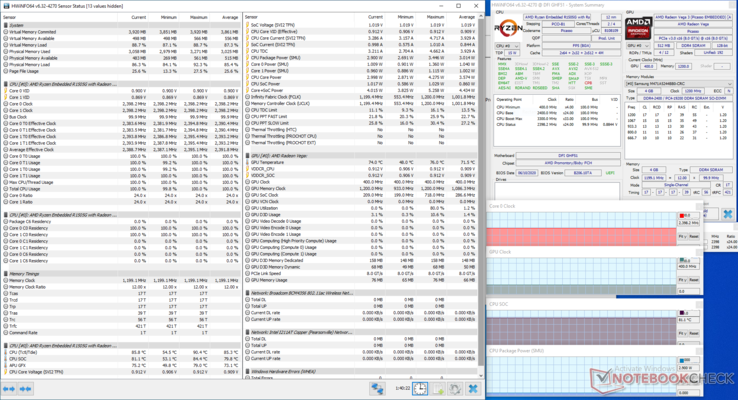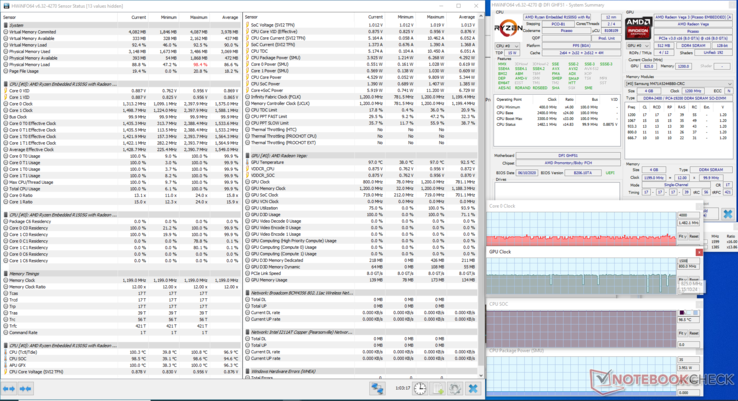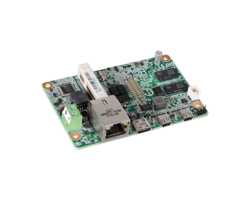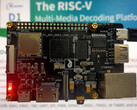DFI GHF51 Single-Board Computer Hands-On
DFI is a Taiwan-based electronics manufacturer that specializes in industrial-grade computer hardware and embedded systems. The company has almost 40 years of experience. DFI has leveraged that history to produce the GHF51, a tiny credit-card-sized single-board computer (SBC).
Upon first glance, the GHF51 is reminiscent of the Raspberry Pi. However, the GHF51 has a trick up its sleeve: Ryzen. Rather than the typical ARM or Intel Atom CPUs seen on tiny SBCs, DFI has opted for AMD's Ryzen Embedded platform. The Ryzen Embedded R1000 APU boasts two cores, four threads, and Radeon Vega graphics. How does the tiny computer hold up against other heavy hitters in the SBC world? Let's take a look.
Case and Connectivity
The GHF51 is tiny and is roughly the size of the popular Raspberry Pi. Because of that, it is made to fit into small spaces without much fuss. DFI ships the GHF51 as a DIY kit; included in the package are the small 1.8-inch board, a large fin array heatsink, four standoffs, and plenty of accessory cables. While the board is as small as a credit card, the heatsink adds quite a bit of heft. After installing the standoffs and the heatsink, the unit stands at 4.75 cm (~1.875 in).
Port selection is adequate but may be lacking for some. There are two micro HDMI 1.4 ports, a full-sized Gigabit Ethernet jack, and a single USB 3.1 Gen 2 (10 Gb/s) Type-C port. Users that need to connect more than a single peripheral (say, a mouse and a keyboard at the same time) will need a USB hub. There is a power terminal that requires users to screw in wires from their own power adapter; there isn't a "plug-and-play" option. DFI sells a compatible power supply for an extra charge.
The GHF51 has one mini PCIe slot. DFI shipped a Wi-Fi card with this unit that required a bracket (also included) to fit into this slot. Wi-Fi connections worked well. While not the speediest connection, it was nonetheless reliable with no dropped connections over a 15-meter distance from my router.
Performance, Emissions, and Heat
The GHF51 can be specced with one of a handful of AMD Ryzen Embedded APUs. The Ryzen Embedded 1505G in our unit is a low-power dual-core CPU with four threads (via SMT). The 1505G has a base frequency of 2.4 GHz with a boost to 3.3 GHz and is rated at 12 Watts.
The GHF51 is designed specifically for industrial and enterprise use. In that regard, the plucky 1505G performs well. It offers a good balance between adequate computing prowess and low power draw. It manages to best Intel's Celeron J4000 series chips in most benchmarks. The Intel Core i3-8145U used in the Lenovo ThinkCentre M90n Nano IoT, a popular option for enterprise use, handily beats the GHF51, albeit with a higher power draw and a significantly larger case.
The GHF51 is limited in a few key areas. Primarily among these is storage; our unit is equipped with only 32 GB of eMMC storage. While this may be enough for specified use, there is no easy way to expand it. DFI also sells units with 16 or 64 GB.
Another drawback is the RAM. DFI sells the GHF51 with either 4 or 8 GB of single-channel DDR4 RAM. While this is enough to run Windows 10 IoT Enterprise (included) adequately, some users may find it limiting.
Considering the GHF51's intended purpose, the RAM and storage should be sufficient for specified use.
Cinebench R15: CPU Single 64Bit | CPU Multi 64Bit
Blender: v2.79 BMW27 CPU
7-Zip 18.03: 7z b 4 -mmt1 | 7z b 4
Geekbench 5.5: Single-Core | Multi-Core
HWBOT x265 Benchmark v2.2: 4k Preset
LibreOffice : 20 Documents To PDF
R Benchmark 2.5: Overall mean
| Cinebench R20 / CPU (Single Core) | |
| Average of class Desktop (674 - 902, n=12, last 2 years) | |
| DFI GHF51-BN-43R15 | |
| Average AMD Ryzen Embedded R1505G (n=1) | |
| GMK NucBox K1 | |
| Chuwi LarkBox 4K Mini PC | |
| Cinebench R20 / CPU (Multi Core) | |
| Average of class Desktop (5710 - 16722, n=12, last 2 years) | |
| DFI GHF51-BN-43R15 | |
| Average AMD Ryzen Embedded R1505G (n=1) | |
| Chuwi LarkBox 4K Mini PC | |
| GMK NucBox K1 | |
| Cinebench R15 / CPU Single 64Bit | |
| Average of class Desktop (246 - 356, n=16, last 2 years) | |
| Lenovo ThinkCentre M90n-1 Nano | |
| Lenovo ThinkCentre M90n-1 Nano IoT | |
| DFI GHF51-BN-43R15 | |
| Average AMD Ryzen Embedded R1505G (n=1) | |
| GMK NucBox K1 | |
| Chuwi LarkBox 4K Mini PC | |
| Cinebench R15 / CPU Multi 64Bit | |
| Average of class Desktop (2652 - 6588, n=16, last 2 years) | |
| Lenovo ThinkCentre M90n-1 Nano | |
| Lenovo ThinkCentre M90n-1 Nano IoT | |
| DFI GHF51-BN-43R15 | |
| Average AMD Ryzen Embedded R1505G (n=1) | |
| Chuwi LarkBox 4K Mini PC | |
| GMK NucBox K1 | |
| Blender / v2.79 BMW27 CPU | |
| GMK NucBox K1 | |
| Chuwi LarkBox 4K Mini PC | |
| DFI GHF51-BN-43R15 | |
| Average AMD Ryzen Embedded R1505G (n=1) | |
| Average of class Desktop (75 - 218, n=14, last 2 years) | |
| 7-Zip 18.03 / 7z b 4 -mmt1 | |
| Average of class Desktop (5092 - 8392, n=14, last 2 years) | |
| DFI GHF51-BN-43R15 | |
| Average AMD Ryzen Embedded R1505G (n=1) | |
| GMK NucBox K1 | |
| Chuwi LarkBox 4K Mini PC | |
| 7-Zip 18.03 / 7z b 4 | |
| Average of class Desktop (54166 - 163125, n=14, last 2 years) | |
| Chuwi LarkBox 4K Mini PC | |
| GMK NucBox K1 | |
| DFI GHF51-BN-43R15 | |
| Average AMD Ryzen Embedded R1505G (n=1) | |
| Geekbench 5.5 / Single-Core | |
| Average of class Desktop (1755 - 2559, n=27, last 2 years) | |
| DFI GHF51-BN-43R15 | |
| Average AMD Ryzen Embedded R1505G (n=1) | |
| GMK NucBox K1 | |
| Chuwi LarkBox 4K Mini PC | |
| Geekbench 5.5 / Multi-Core | |
| Average of class Desktop (12626 - 26186, n=27, last 2 years) | |
| Chuwi LarkBox 4K Mini PC | |
| GMK NucBox K1 | |
| DFI GHF51-BN-43R15 | |
| Average AMD Ryzen Embedded R1505G (n=1) | |
| HWBOT x265 Benchmark v2.2 / 4k Preset | |
| Average of class Desktop (18.6 - 48.5, n=12, last 2 years) | |
| Chuwi LarkBox 4K Mini PC | |
| GMK NucBox K1 | |
| DFI GHF51-BN-43R15 | |
| Average AMD Ryzen Embedded R1505G (n=1) | |
| LibreOffice / 20 Documents To PDF | |
| DFI GHF51-BN-43R15 | |
| Average AMD Ryzen Embedded R1505G (n=1) | |
| Chuwi LarkBox 4K Mini PC | |
| GMK NucBox K1 | |
| Average of class Desktop (35.5 - 79.2, n=13, last 2 years) | |
| R Benchmark 2.5 / Overall mean | |
| GMK NucBox K1 | |
| DFI GHF51-BN-43R15 | |
| Average AMD Ryzen Embedded R1505G (n=1) | |
| Average of class Desktop (0.3307 - 0.4909, n=13, last 2 years) | |
* ... smaller is better
| DFI GHF51-BN-43R15 | Lenovo ThinkCentre M90n-1 Nano IoT Samsung SSD PM981a MZVLB256HBHQ | Lenovo ThinkCentre M90n-1 Nano Samsung SSD PM981 MZVLB512HAJQ | GMK NucBox K1 HIKVision C100 NGFF SSD 128GB | Chuwi LarkBox 4K Mini PC 128 GB eMMC Flash | Global Average -3 | Average of class Desktop | ||
|---|---|---|---|---|---|---|---|---|
| CrystalDiskMark 5.2 / 6 | 533% | 965% | 134% | -35% | 1290% | 3106% | ||
| Write 4K (MB/s) | 32.94 | 87.2 165% | 130 295% | 77.1 134% | 26.02 -21% | 146.8 ? 346% | 258 ? 683% | |
| Read 4K (MB/s) | 23.98 | 36.03 50% | 45.61 90% | 20.12 -16% | 16.33 -32% | 56.5 ? 136% | 80.3 ? 235% | |
| Write 4K Q32T1 (MB/s) | 37.11 | 207.8 460% | 365.3 884% | 123.5 233% | 28.76 -23% | 409 ? 1002% | 714 ? 1824% | |
| Read 4K Q32T1 (MB/s) | 76 | 149.5 97% | 350.2 361% | 70.9 -7% | 17.41 -77% | 483 ? 536% | 877 ? 1054% | |
| Write Seq Q32T1 (MB/s) | 98.6 | 1896 1823% | 2986 2928% | 445.9 352% | 59 -40% | 2544 ? 2480% | 6596 ? 6590% | |
| Read Seq Q32T1 (MB/s) | 261.5 | 2268 767% | 3565 1263% | 550 110% | 218.8 -16% | 3568 ? 1264% | 7176 ? 2644% | |
| Write 4K Q8T8 (MB/s) | 36.61 | 207.7 467% | 368.7 907% | 1091 ? 2880% | 3048 ? 8226% | |||
| Read 4K Q8T8 (MB/s) | 72.2 | 383.3 431% | 790 994% | 1281 ? 1674% | 2667 ? 3594% |
GPU
While not the main draw of the GHF51, the Ryzen Embedded APUs all share the same decent integrated GPU: the Radeon RX Vega 3. While certainly not a graphical powerhouse, the Vega 3 iGPU is on par with the Intel UHD Graphics 620 used in most Intel computers. The Vega 3 beats the Intel UHD Graphics 600 used in Celeron systems (and other low-powered Intel devices) by a wide margin.
System Noise and Thermal Management
One of the main draws of the GHF51 is its fanless design. The unit ships with a massive heatsink that sits on top of the AMD APU. Since it is fanless, the unit is completely silent while in operation. I also did not notice coil whine.
Despite its lack of fans, the GHF51 does not get unbearably hot. Under full synthetic load (Prime95 and FurMark for 1 hour), the APU stays rock solid at 2.4 GHz for the first 10 minutes as its temperature slowly ramps up to 100 °C. Once it hits this threshold, the CPU heavily throttles to 1.4 GHz, but temperatures stay at 98-99 °C. The heat sink gets painfully hot to the touch, measuring 65-70 °C.
Placing only the CPU under load sees better results. The chip keeps a perfectly constant 2.4 GHz clock, though temperatures rise to 81 °C. Otherwise, the system is completely stable.
In sum, as long as the Vega 3 GPU isn't taxed, the GHF51 should be able to endure computationally stressful loads for long periods of time.
Verdict
The DFI GHF51 is an interesting device. While at first glance it looks to be a significantly more powerful Raspberry Pi, its target market is not the same as the Pi's. Hobbyists may be enticed by the available AMD Ryzen Embedded R1000 family, but the limited port selection and high price tag (~US$333 for this review unit) will turn most off.
That's fine, as the GHF51 isn't intended for general consumers. This is a tiny SBC meant for industrial and enterprise use. Think robotics on an assembly line, Internet-of-Things applications, and other highly specific use cases. Professionals looking for a compact device to manage enterprise-level tasks will want to keep the GHF51 in mind.
They'll also want to keep its shortcomings in mind as well. The high temperatures recorded over stress tests cause a bit of concern, especially for continuous use. Also, the slow and small eMMC storage drive may limit some uses, particularly when high levels of data reads and writes are needed. Still, the GHF51 is a solid little computer designed for highly specific uses.
Considering its high computational power relative to other credit card-sized SBCs, the GHF51 offers a lot in its tiny package.
The DFI GHF51 can be purchased directly from DFI. Prices range from $293 to $378, depending on the APU selected.
Disclaimer: The author of this review received the DFI GHF51 single-board computer free of charge for the purpose of testing.



